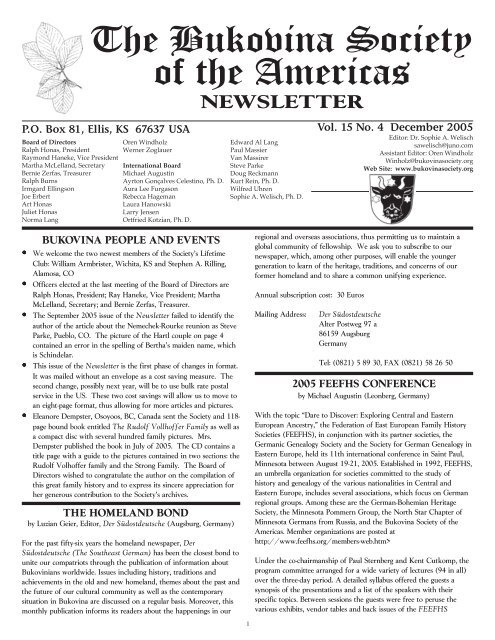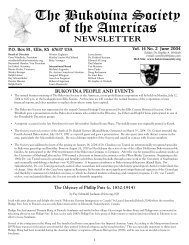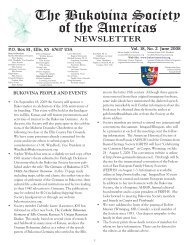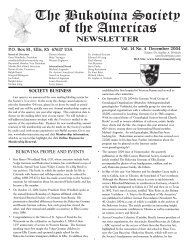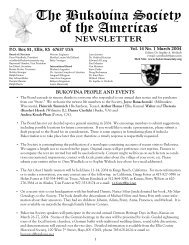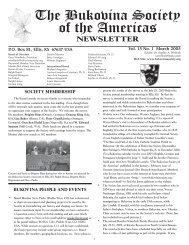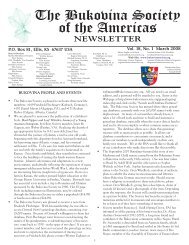Buko-NL-2005-4-Dec-Bukovina-Society-Newsletter
Buko-NL-2005-4-Dec-Bukovina-Society-Newsletter
Buko-NL-2005-4-Dec-Bukovina-Society-Newsletter
You also want an ePaper? Increase the reach of your titles
YUMPU automatically turns print PDFs into web optimized ePapers that Google loves.
Board of Directors<br />
Ralph Honas, President<br />
Raymond Haneke, Vice President<br />
Martha McLelland, Secretary<br />
Bernie Zerfas, Treasurer<br />
Ralph Burns<br />
Irmgard Ellingson<br />
Joe Erbert<br />
Art Honas<br />
Juliet Honas<br />
Norma Lang<br />
The <strong>Buko</strong>vina <strong>Society</strong><br />
of the Americas<br />
NEWSLETTER<br />
P.O. Box 81, Ellis, KS 67637 USA<br />
Oren Windholz<br />
Werner Zoglauer<br />
International Board<br />
Michael Augustin<br />
Ayrton Gonçalves Celestino, Ph. D.<br />
Aura Lee Furgason<br />
Rebecca Hageman<br />
Laura Hanowski<br />
Larry Jensen<br />
Ortfried Kotzian, Ph. D.<br />
BUKOVINA PEOPLE AND EVENTS<br />
• We welcome the two newest members of the <strong>Society</strong>’s Lifetime<br />
Club: William Armbrister, Wichita, KS and Stephen A. Rilling,<br />
Alamosa, CO<br />
• Officers elected at the last meeting of the Board of Directors are<br />
Ralph Honas, President; Ray Haneke, Vice President; Martha<br />
McLelland, Secretary; and Bernie Zerfas, Treasurer.<br />
• The September <strong>2005</strong> issue of the <strong>Newsletter</strong> failed to identify the<br />
author of the article about the Nemechek-Rourke reunion as Steve<br />
Parke, Pueblo, CO. The picture of the Hartl couple on page 4<br />
contained an error in the spelling of Bertha’s maiden name, which<br />
is Schindelar.<br />
• This issue of the <strong>Newsletter</strong> is the first phase of changes in format.<br />
It was mailed without an envelope as a cost saving measure. The<br />
second change, possibly next year, will be to use bulk rate postal<br />
service in the US. These two cost savings will allow us to move to<br />
an eight-page format, thus allowing for more articles and pictures.<br />
• Eleanore Dempster, Osoyoos, BC, Canada sent the <strong>Society</strong> and 118page<br />
bound book entitled The Rudolf Vollhoffer Family as well as<br />
a compact disc with several hundred family pictures. Mrs.<br />
Dempster published the book in July of <strong>2005</strong>. The CD contains a<br />
title page with a guide to the pictures contained in two sections: the<br />
Rudolf Volhoffer family and the Strong Family. The Board of<br />
Directors wished to congratulate the author on the compilation of<br />
this great family history and to express its sincere appreciation for<br />
her generous contribution to the <strong>Society</strong>’s archives.<br />
THE HOMELAND BOND<br />
by Luzian Geier, Editor, Der Südostdeutsche (Augsburg, Germany)<br />
For the past fifty-six years the homeland newspaper, Der<br />
Südostdeutsche (The Southeast German) has been the closest bond to<br />
unite our compatriots through the publication of information about<br />
<strong>Buko</strong>vinians worldwide. Issues including history, traditions and<br />
achievements in the old and new homeland, themes about the past and<br />
the future of our cultural community as well as the contemporary<br />
situation in <strong>Buko</strong>vina are discussed on a regular basis. Moreover, this<br />
monthly publication informs its readers about the happenings in our<br />
Edward Al Lang<br />
Paul Massier<br />
Van Massirer<br />
Steve Parke<br />
Doug Reckmann<br />
Kurt Rein, Ph. D.<br />
Wilfred Uhren<br />
Sophie A. Welisch, Ph. D.<br />
1<br />
Vol. 15 No. 4 <strong>Dec</strong>ember <strong>2005</strong><br />
Editor: Dr. Sophie A. Welisch<br />
sawelisch@juno.com<br />
Assistant Editor: Oren Windholz<br />
Winholz@bukovinasociety.org<br />
Web Site: www.bukovinasociety.org<br />
regional and overseas associations, thus permitting us to maintain a<br />
global community of fellowship. We ask you to subscribe to our<br />
newspaper, which, among other purposes, will enable the younger<br />
generation to learn of the heritage, traditions, and concerns of our<br />
former homeland and to share a common unifying experience.<br />
Annual subscription cost: 30 Euros<br />
Mailing Address: Der Südostdeutsche<br />
Alter Postweg 97 a<br />
86159 Augsburg<br />
Germany<br />
Tel: (0821) 5 89 30, FAX (0821) 58 26 50<br />
<strong>2005</strong> FEEFHS CONFERENCE<br />
by Michael Augustin (Leonberg, Germany)<br />
With the topic “Dare to Discover: Exploring Central and Eastern<br />
European Ancestry,” the Federation of East European Family History<br />
Societies (FEEFHS), in conjunction with its partner societies, the<br />
Germanic Genealogy <strong>Society</strong> and the <strong>Society</strong> for German Genealogy in<br />
Eastern Europe, held its 11th international conference in Saint Paul,<br />
Minnesota between August 19-21, <strong>2005</strong>. Established in 1992, FEEFHS,<br />
an umbrella organization for societies committed to the study of<br />
history and genealogy of the various nationalities in Central and<br />
Eastern Europe, includes several associations, which focus on German<br />
regional groups. Among these are the German-Bohemian Heritage<br />
<strong>Society</strong>, the Minnesota Pommern Group, the North Star Chapter of<br />
Minnesota Germans from Russia, and the <strong>Buko</strong>vina <strong>Society</strong> of the<br />
Americas. Member organizations are posted at<br />
http://www.feefhs.org/members-web.htm><br />
Under the co-chairmanship of Paul Sternberg and Kent Cutkomp, the<br />
program committee arranged for a wide variety of lectures (94 in all)<br />
over the three-day period. A detailed syllabus offered the guests a<br />
synopsis of the presentations and a list of the speakers with their<br />
specific topics. Between sessions the guests were free to peruse the<br />
various exhibits, vendor tables and back issues of the FEEFHS
Journal in the main foyer of the Four Points Sheraton, the hotel at<br />
which the conference was held.<br />
More than 300 people attended the conference, including four<br />
members of the <strong>Buko</strong>vina <strong>Society</strong> who made formal presentations.<br />
Irmgard Ellingson spoke on “Galician and <strong>Buko</strong>vina German Genealogy”<br />
and “The Ethnic and Religious Nature of Austria-Hungary,”<br />
while Michael Augustin, Sophie Welisch and Werner Zoglauer<br />
discussed “The <strong>Buko</strong>vina German Experience 1919-1955: Resettlement,<br />
Flight and Expulsion,” with each speaker focusing on one<br />
chronological period.<br />
The next FEEFHS conference is tentatively scheduled for 2007 in Chicago.<br />
The Kozsan/Molnar/Kajtar/<br />
Lovasz Hungarian Reunion<br />
by Andrea Kozan Phan (Poway, CA)<br />
Between July 30-31, <strong>2005</strong> a large group of descendants of the<br />
Kozsan/Molnar/Kajtar/ Lovasz families assembled for their first<br />
gathering in Saskatchewan, Canada to honor their <strong>Buko</strong>vina Székely<br />
heritage. The first day’s events were held in Cupar, and then continued<br />
the following day at the Hungarian Club Hall in neighboring<br />
Regina.<br />
Over 200 family members traveled from the Canadian provinces of<br />
Alberta, British Columbia, Saskatchewan and Quebec as well as from<br />
California, Idaho, Michigan, Montana, Tennessee and Oregon in the<br />
United States to reminisce, meet new family members, and learn more<br />
about their Székely Hungarian heritage. Scheduled events included a<br />
presentation on the Székely Hungarians from <strong>Buko</strong>vina, Hungarian<br />
dancers, Hungarian bands, horse and wagon rides, tours to cemeteries<br />
and homesteads, and good Hungarian cooking.<br />
The Kozsan/Molnar/Kajtar/Lovasz families originating from the<br />
Székely villages of Istensegíts and Hadikfalva in <strong>Buko</strong>vina immigrated<br />
to Cupar between 1907-1926. At about this same time we also find<br />
Hungarians from the Székely <strong>Buko</strong>vinian villages of Foganjisten,<br />
Józseffalva and Andrásfalva settling in Cupar. The Székely had<br />
founded these five villages in <strong>Buko</strong>vina in 1785-86.<br />
Due to great distances separating the families and their large numbers,<br />
some uncles met their nieces and nephews for the first time; others<br />
met cousins known previously only by name. It proved to be a<br />
touching experience for all attendees.<br />
Through the research of Elizabeth Long and Rudolf Laszlo (see “The<br />
<strong>Buko</strong>vina Székely Genealogy Project” in the <strong>Buko</strong>vina <strong>Society</strong>’s<br />
<strong>Newsletter</strong>, Vol. 13, No. 4, <strong>Dec</strong>ember 2003, pp 4-6), two family trees<br />
including all attendees could be developed. One family tree, extending<br />
over 33 feet when posted, originated with Imre Kozsan. Born in 1739,<br />
Imre migrated from Transylvania to <strong>Buko</strong>vina and participated in the<br />
founding of the village of Istensegíts. The second family tree for the<br />
descendants of Andras Molnar born in 1763, reached over 20 feet.<br />
Each attendee was asked to highlight his/her box on one of the trees.<br />
We greatly appreciate the ability to connect with people who one year<br />
ago did not know of their relationship to each other. Some of the<br />
networking resulted from the posting of messages on the <strong>Buko</strong>vina<br />
<strong>Society</strong>’s website, www.bukovinasociety.org.<br />
2<br />
The Kozsan/Molnar/Kajtar/Lovasz “Convention” was a great<br />
success. It can be safely stated that the participants found the experience<br />
to be both fulfilling and exhilarating and that they look forward<br />
to continued contacts with their newly discovered relatives.<br />
A TRIBUTE<br />
by Sophie A. Welisch (Congers, NY)<br />
It is with sadness and regret that we learn of the resignation of Oren<br />
Windholz as President of the <strong>Buko</strong>vina <strong>Society</strong>. At the helm since its<br />
founding in 1988, Oren has spearheaded many of the <strong>Society</strong>’s projects<br />
and activities over his seventeen years in office. Under his aegis the<br />
<strong>Buko</strong>vina <strong>Society</strong> has become firmly established with a headquarters<br />
building in Ellis, KS, a museum, an archival collection housed in the<br />
library of Fort Hays University, numerous publications, a web site, and<br />
a quarterly <strong>Newsletter</strong>.<br />
As the area in the USA with the highest concentration of <strong>Buko</strong>vina<br />
Germans, Kansas was early identified as the location most suited for<br />
the <strong>Society</strong>’s permanent headquarters. Following his trip to <strong>Buko</strong>vina<br />
and a visit with leading figures in the Landsmannschaft der<br />
Buchenlanddeutschen (Augsburg, Germany), invitations went out in<br />
1989 for the first conference of scholars and laymen interested in<br />
promoting the history and culture of <strong>Buko</strong>vina. Numerous conferences<br />
followed in the intervening years during which Oren and his wife Pat<br />
opened their home to out-of-town guests.<br />
Oren has authored numerous articles about <strong>Society</strong> matters, which<br />
have been published in journals and newspapers in the United States<br />
and Germany; in addition, he has been a speaker at conventions in<br />
both the USA and abroad. To facilitate the smooth and efficient<br />
functioning of the <strong>Society</strong> one could always rely on Oren promptly to<br />
respond to the considerable volume of correspondence, which crossed<br />
his desk and his computer. Through his efforts contacts were made<br />
and maintained with other cultural institutions including FEEFHS and<br />
our counterpart organization in Brazil, the Associacão Alemã-<br />
Bucovina de Cultura – ABC in Rio Negro, Brazil.<br />
The Board of Directors, the International Board, the membership, and<br />
all those whose lives Oren has touched over the years wish to express<br />
their heartfelt gratitude and appreciation for all he has done for the<br />
<strong>Society</strong> and its advancement. We look forward to continued collaboration<br />
with Oren and at the same time extend to Ralph Honas, his<br />
successor in office, our congratulations and best wishes for a fruitful<br />
presidency.<br />
THE PEKAR/BAKER/BEKAR FAMILY<br />
REUNION IN CHILLIWACK, BC<br />
by Joe and Kathy Rieberger (Cranbrook, British Columbia, Canada)<br />
This year witnessed another successful family reunion of the descendants<br />
of Josef and Ludvina Pekar, who in 1912 immigrated to<br />
Saskatchewan, Canada from Paltinossa, <strong>Buko</strong>vina. The first reunion<br />
took place in Creston, BC in 1965 in celebration of Sister Rose Bekar’s<br />
silver jubilee as a Sister of Providence. Sister Rose is the fifteenth child<br />
of Josef and Ludvina and the last of her siblings. We were delighted<br />
that she was able to attend the Chilliwack reunion and to entertain us<br />
by a reading of her memoirs as a nursing sister. In the near future Sr.<br />
Rose plans to retire to the motherhouse in Kingston, Ontario. Gilberte<br />
Baker, who lives in Kanata, Ontario, is the last living in-law of this<br />
generation but was unable to attend.
Approximately 200 family members gathered at the <strong>2005</strong> reunion<br />
including an American cousin, Bill Carr and his wife Jean from<br />
Indianapolis, Indiana. Bill is the grandson of Mathias Pekar and Marie<br />
Hicke, who emigrated from Paltinossa in 1903. Barney Baker from<br />
Kanata, Ontario, traveled the furthest from within Canada. Joan<br />
Galey, daughter of Clem Bekar, presented a twenty-two page booklet<br />
on the history of the Pekar family. In addition, there were numerous<br />
items for sale including tee shirts, caps with the family<br />
name and crest, plaques, key chains and various other memorabilia. A<br />
CD with family photos will soon be available.<br />
Since 1965 the family reunions have been held every five years in<br />
different provinces of Canada with the next one scheduled in 2009<br />
near Calgary, Alberta. A centennial celebration of Josef and Ludvina’s<br />
arrival in Canada will take place in 2012.<br />
MY VISIT TO VOLOCA, BUKOVINA<br />
by Jim Ursulak (Nanaimo, British Columbia, Canada)<br />
I turned 72 on June 13, <strong>2005</strong>.<br />
About twenty years ago, shortly after I got my first computer, I created<br />
a spreadsheet and was the first Ursulak to construct our family tree<br />
using a computer. Later I obtained a genealogy program and over the<br />
years greatly expanded and shared the information with relatives. This<br />
hunting for roots also created an itch. “Some day,” I mused, “I may<br />
actually see the town where my father was born.” I once casually<br />
expressed this wish to my son and to my surprise he indicated that he<br />
would like to join me as it would be an excellent experience for both<br />
of us. Two years later, in May 2004, I scratched that itch and saw<br />
Voloca, <strong>Buko</strong>vina, the birthplace of my father. In 1897, the year he<br />
was born, <strong>Buko</strong>vina belonged to Austria-Hungary. In 1918, after<br />
World War I, it was turned over to Romania and remained so until<br />
the end of World War II when Russia again redrew the border and<br />
incorporated northern <strong>Buko</strong>vina into the Ukrainian Soviet Socialist<br />
Republic.<br />
My father was three years old when he came to Canada and like many<br />
others, his family had no papers when they passed through immigration.<br />
In 1939 dad applied for a copy of his birth certificate to obtain<br />
proof of age to confirm a bona fide registration in Canada. As a<br />
youngster I was puzzled by the fact that my dad was “Austrian”<br />
although our family was clearly Romanian. These border shifts explain<br />
why his birth certificate, issued in 1939, bears a Romanian postage<br />
stamp.<br />
Jimmy, my only son, is an experienced globetrotter. As a field sound<br />
engineer for television productions his profession has taken him<br />
around the world many times. (He currently works with film crews<br />
that produce the popular episodes of Survivor and Amazing Race.)<br />
His work once took him to Moscow where he spent several months<br />
and acquired a working knowledge of the Russian language. Jimmy has<br />
reached the point where he can communicate with Russians or<br />
Ukrainians well enough to act as an interpreter. I, on the other hand,<br />
except for “dobra, dobra” can’t speak Ukrainian and just know a few<br />
words in Romanian. It was no longer spoken in my family when I<br />
came on the scene.<br />
Jimmy took care of all the preparations and used his regular travel<br />
agent Myrna Arychuk of Times Square Travel Ltd in Richmond, BC<br />
to make our bookings. On May 6th, Jimmy and I headed for the old<br />
3<br />
country. We flew to Heathrow, London, rested overnight, and then<br />
continued on to Kiev the next day. I have traveled quite a bit and<br />
have flown on many different airlines but after this trip, I wouldn’t<br />
hesitate to say that British Air is the only way to fly!<br />
We were met at the Kiev airport by our personal tour guide Svetlana<br />
and her driver who were booked for us by Jimmy’s travel agent. She<br />
took us everywhere to see the sights of Kiev. I am a musician and<br />
particularly wanted to see the Great Gate of Kiev, which is musically<br />
depicted in Moussorgsky’s classic Pictures at an Exhibition. This<br />
ancient structure is still standing and is known as “The Golden Gate.”<br />
That night we slept on a train from Kiev to Lviv. We had first class<br />
accommodations in a compartment for two. This, too, had been<br />
booked by Times Square Travel but after Lviv we would be on our<br />
own. We arrived in Lviv at 7:00 A.M. and considered taking either a<br />
train or bus to Chernivtsi [Czernowitz] but when a cab driver offered<br />
to drive us there for only $75 Canadian we quickly accepted. It was a<br />
very interesting trip and signs of a growing economy in that region<br />
were evident. Many of the gasoline stations along the route are new<br />
(gas is 59 cents Canadian per liter) and every new home under<br />
construction was being built with red brick. There was lots of construction<br />
and many signs of expansion along the route. Still, I saw numerous<br />
elderly peasants along the way, sitting by the roadside waiting<br />
while the family cow grazed nearby on the free grass by the highway.<br />
After a speedy comfortable three-hour ride, we arrived at Hotel<br />
<strong>Buko</strong>vina in the center of Chernivtsi. Room rates were incredibly<br />
cheap so we booked separate rooms. They were spacious with high<br />
ceilings and some included a balcony equipped with a table and chairs<br />
and flowers in the planter overlooking the front of the hotel. This<br />
large old five-story building was once used to accommodate KGB<br />
officials. My bathroom had an enormous deep tub with a handoperated<br />
showerhead and a “different” version of a flush toilet. The<br />
hotel provided one tiny, tightly rolled packet of unbleached toilet<br />
paper. (I was glad that I had brought my own and kept their TP as a<br />
souvenir). The cost? Only $28 Canadian per night, and this included<br />
breakfast! Obviously Chernivtsi has yet to be discovered in the tourist<br />
world.<br />
Of course most items on the menu were tasty Ukrainian dishes so we<br />
had most of our meals in the hotel. The cost, with a 10 percent tip,<br />
was less than $10 per person. This included a large bottle of excellent<br />
Ukrainian beer. Jimmy loves this city and wants to return. He wandered<br />
about by himself taking numerous photos with his camera and<br />
camcorder. Early every morning one will see elderly people, mostly<br />
women, sweeping the sidewalks and the cobblestone streets with<br />
handmade willow branch brooms. I was impressed at how clean the<br />
city appeared the day following May 9th, “Victory Day” (VE Day), a<br />
special day to celebrate the end of Nazi occupation. No litter but<br />
……hmm, unfortunately spitting is still tolerated and evidently a<br />
common practice. I also noted that stray dogs of all sizes run freely<br />
about the city, even in Kiev.<br />
The day after we arrived we planned to locate the regional archives<br />
building and inquire about my father’s registration. I had a copy of his<br />
birth certificate, which in Romanian stated his birth as “1897, August<br />
17” and his parents “Stefan a Nicolaea Ursuleac” and “Zoita nascuta<br />
Ili”. We finally found the archives after searching all morning. There<br />
was an unexpectedly long queue of elderly folk in the waiting room,<br />
but we eventually got our turn to speak to an official. No luck. He directed us to<br />
the “other” archives building where the older records are kept.
Well, since we had not yet seen the village of Voloca, which is about a<br />
15-minute drive away, we decided to take a cab and scout the town.<br />
Jimmy told the driver we would probably spend about ten minutes or<br />
so in Voloca and then return to our hotel. The village is beautifully<br />
nestled among rolling hills with farmland everywhere you looked. Our<br />
driver stopped to ask a local for directions to the town center. Jimmy<br />
took this opportunity to get out of the cab and he showed dad’s birth<br />
certificate to an old fellow, explaining that our mission was to find out<br />
if any Ursulaks still lived in Voloca. This old guy’s name was Teodor.<br />
His face lit up and he waved his arms about and instantly and loudly<br />
proclaimed that he would help us and, without invitation, jumped into<br />
our cab. For the next hour or so, he took us from house-to-house,<br />
field-to-field and presented dad’s birth certificate and a large computer<br />
printout photo, which I also brought with me of Stefan and Zoita<br />
Ursuleac (my grandparents).<br />
Most people he approached were quite old and noticeably dubious and<br />
uncertain. We gave it a good try and were ready to give up after<br />
about eight inquiries, but Teodor insisted “just one more place.” He<br />
would not give up. Our patient cab driver silently just went along with<br />
the flow. Finally we struck gold when Teodor went into an old<br />
whitewashed, steep-roofed cottage, similar to farmhouses I had seen<br />
which belonged to my relatives when I lived in Manitoba in the<br />
thirties. This house had electricity but no plumbing.<br />
He came out a moment later, his face beaming, and shouted loudly for<br />
us to come in while he frantically beckoned us with both arms. He<br />
found a ninety-year-old old woman whose maiden name was Domnica<br />
Ursuleac. Her daughter Maria and her husband also happened to be<br />
there. When Domnica saw the photo of Stefan she smiled and softly<br />
said,” This is my Uncle Stefan” and kissed the picture. I wish I could<br />
have captured that moment on video. What a stroke of luck that her<br />
vision was not impaired and she could recognize the features of the<br />
elderly couple in that photo! From that moment on, Jimmy and I were<br />
in the midst of jubilation. We were squeezed with hugs, and were<br />
kissed by women and men! There were tears of joy on all the faces. It<br />
was a magic moment that still brings a tear to my eyes when I think of<br />
it. Oh how I regretted that I could not understand Romanian!<br />
I learned that Domnica’s father Grigori, previously unknown to me,<br />
was Stefan’s brother; therefore, Domnica and my father, who passed<br />
away in 1973, were first cousins. Well, it was a time to celebrate! This<br />
lovely, serene old lady, who was born and continues to live in this 100year-old<br />
cottage, dropped to her knees and crawled across the floor and<br />
went under the kitchen table to some hiding place and came out<br />
smiling as she held up a large bottle of vodka. Maria disappeared for a<br />
while, then returned with a few plates of hurriedly prepared snacks<br />
while her husband kept our glasses charged with vodka and beer. In<br />
true old country fashion we were urged to eat, eat, eat!!<br />
Maria’s daughter, a schoolteacher, joined us, then Maria’s sister Stella<br />
arrived on the scene. Poor Jimmy, the only one who could communicate,<br />
was deluged with questions and did his best to respond to all of<br />
those eager faces. He must have been doing a great job because they<br />
smiled and nodded with pleasure to his responses. Meanwhile outside,<br />
the cab driver waited and waited patiently for us. Ten minutes! Ha!<br />
About an hour or so later we emerged and intended to take Teodor to<br />
his home and then return to our hotel. Nope! He protested and loudly<br />
insisted that we accompany him to his “club.” He wanted to introduce<br />
us and announce his personal triumph to his friends and to buy us a<br />
round. This resulted in more beer and vodka and Kielbassa etc., etc.<br />
4<br />
When we finally returned to our hotel, we paid the cab driver double<br />
the cab fare that he requested, so he too was happy with how the day<br />
had passed. We arranged to come back to Domnica’s home the next<br />
day to meet more relatives.<br />
Domnica’s House<br />
The next day we hunted for that “other archives building” in<br />
Chernivtsi, which turned out to be a large ancient church no longer<br />
used for that purpose. If we were prepared possibly to wait several<br />
hours (because this queue was even longer than that of the day<br />
before), perhaps we might get in and find my dad’s registration. We<br />
waited for a while and then I said, “Why are we wasting our valuable<br />
time? We have already FOUND our relatives, so what more do we<br />
need?” At 1:00 P.M. our faithful cab driver took us back to Domnica’s<br />
and we began another afternoon of excited chatter. We went from<br />
house to house and met more relatives stemming from Grigori<br />
Ursuleac. I met Domnica’s other daughters, a granddaughter, a greatgranddaughter<br />
and husbands, etc., etc.<br />
I encountered numerous familiar names such as Gorda, Pentlichuk,<br />
Chescu. (One individual in particular, Nicolai Gorda, a dentist, has a<br />
brand new, exceptionally beautiful house so some members of his<br />
generation are doing quite well.) He said he had visited Chescu and<br />
Gorda families in Inglis and Russell, Manitoba about nine years ago. I<br />
said, “INGLIS ??? I was BORN in Inglis!!!” and that set off a new<br />
round of excitement and more questions.<br />
One special moment during that second day was seeing the well that<br />
my grandfather had dug. His house is gone but the well is still there.<br />
The royal treatment we received and the numerous toasts with vodka<br />
overwhelmed us until we finally had to say our goodbyes. (On the way<br />
back Jimmy said, “Dad, I’m seeing double!”) We returned loaded with<br />
gifts to take back to Canada. What an amazing experience. Only a few<br />
days earlier we didn’t know each other and now we are family!<br />
Further to explore and learn about this part of the country we decided<br />
to return to Lviv by bus rather than take a cab. It would be cheaper<br />
and certainly more interesting. We had front seats on a rickety old bus<br />
and rubbed elbows with all types of people as they got on and off at<br />
the many villages, and get this, the bus fare was only $4.85 each for<br />
that eight-hour journey!<br />
We again slept on an overnight train from Lviv to Kiev and next day<br />
flew back to Canada. Although our visit to <strong>Buko</strong>vina was brief and the<br />
trip a bit exhausting for someone my age, it was certainly worth every<br />
cent. I bought a memory, which both my son and I will cherish. I was<br />
the first member of my family to have visited Voloca.
THE CATHOLIC CHURCH<br />
IN BUKOVINA*<br />
by Otto Weber<br />
Before the Austrian annexation of <strong>Buko</strong>vina, the Catholic Church<br />
exercised only an insignificant influence here. Until the Great Schism<br />
under the Patriarch Cerularius of Constantinople (1053) <strong>Buko</strong>vina<br />
had been incorporated into the Eastern Roman Church. The bishoprics<br />
of Sereth (Siret) and Baia, founded in 1370 and 1420 respectively, did<br />
not exist long. Founded in 1607, the bishopric of Bacau in Moldavia,<br />
which at that time included <strong>Buko</strong>vina, also soon closed its doors.<br />
Only after Austrian military occupation in 1775 was Church life<br />
organized in <strong>Buko</strong>vina. Between 1775-1786 military chaplains served<br />
not only the occupation forces but the civilian population as well.<br />
When in 1786 <strong>Buko</strong>vina came under Galician administration, the<br />
deaconate of Czernowitz was founded and placed under the administration<br />
of the archdiocese of Lemberg [Lvov/Lviv]. The Catholic<br />
Church of <strong>Buko</strong>vina remained linked with Lemberg until the annexation<br />
of the province by Romania in 1920. With the concordat<br />
between the Holy See and the Kingdom of Romania (August 8, 1930),<br />
jurisdiction passed to the bishopric of Jassy (Iaºi). In the interim the<br />
deaconates of Suczawa (Suceava) and Radautz (Rãdãu+i) had been<br />
founded in 1847 and 1908 respectively. The external organization of<br />
the Roman Catholic hierarchy in <strong>Buko</strong>vina had thus been established.<br />
In the course of time the first parishes were founded and gradually an<br />
active religious and Church life developed. This evolved in several<br />
stages.<br />
Given the rapid increase in the number of the faithful in only a brief<br />
period of time, the activities of the military chaplains no longer<br />
sufficed to render the essential religious services. The archbishop of<br />
Lemberg must have seen this during his first visitation. Since at the<br />
same time the Jesuit Order had been banned in Russia, the brothers,<br />
for the most part Germans, settled in <strong>Buko</strong>vina and undertook<br />
pastoral duties, especially in southern <strong>Buko</strong>vina. Their first station was<br />
Gurahumora, from where they served the Catholics in the Moldavian<br />
Valley and beyond. After the dissolution of the Jesuits (1843),<br />
ministerial work passed to diocesan priests from Galicia. Only at the<br />
beginning of this century did an indigenous clergy arise, which was<br />
naturally better prepared to meet the needs of <strong>Buko</strong>vina. The frequent<br />
attempts to establish a separate diocese in <strong>Buko</strong>vina repeatedly failed.<br />
Nonetheless, the Catholic Church in <strong>Buko</strong>vina had a far-reaching<br />
native administration. It had its own vicar-general, who resided in<br />
Czernowitz.<br />
While pastoral work initially took on a missionary character, it also<br />
began for the first time early in this century to develop a national<br />
orientation, the character of which was shaped by the intermingling of<br />
Polish, Armenian, Ruthenian and German Catholics. Although<br />
Catholicism in <strong>Buko</strong>vina had the stamp of the world Church, an<br />
active national life was unmistakable. Thus in 1907 a Catholic German<br />
youth club was founded in Czernowitz followed in 1913 by the<br />
Regional Association of German Catholic Youth with headquarters in<br />
Radautz. From this organization there arose a series of trade and lay<br />
associations based on religious principles.<br />
Before the [1940] resettlement the following organizations were under<br />
the umbrella of the Central Association of German Catholics: (1) Book<br />
Consultation and Distribution Station, (2) Theater and Picture<br />
5<br />
Consultation Center, (3) Department of Lending Libraries, (4) Legal<br />
Consultation Center for Poor Compatriots, (5) Volunteer Work<br />
Service. In addition there existed the following central organizations:<br />
(1) Catholic German National Association for <strong>Buko</strong>vina, (2) Catholic<br />
German Orphanage Association for <strong>Buko</strong>vina, (3) Catholic German<br />
Press Division, (4) Regional Association of Catholic Youth in<br />
<strong>Buko</strong>vina (with 4 boys’ congregations, 12 girls’ congregations, 4 singles’<br />
clubs, 35 young girls’ clubs, 39 adolescent girls’ clubs, and 4 work<br />
communities of Catholic German youth), (5) <strong>Buko</strong>vina Boniface Club,<br />
(6) Diocesan Charity Club for <strong>Buko</strong>vina, (7) Catholic German School<br />
Organization for <strong>Buko</strong>vina, and (8) the <strong>Society</strong> for the Fostering and<br />
Advancement of Church Music.<br />
Without direct linkage to the Central Association, there was also a<br />
Catholic German People’s Bank for <strong>Buko</strong>vina and the Catholic<br />
German student fraternity, “Frankonia.”<br />
Through the associations there arose a secular and ethnic life, which<br />
was especially active among the German Catholics. The customs and<br />
practices were throughout religious. Many had been brought from the<br />
homeland and were zealously guarded, as for example the traditions<br />
relating to weddings, baptisms and funerals. The Church year was also<br />
replete with activities: Advent celebration, but especially the visits of<br />
the “singers” at Christmas and of the Three Kings on Three Kings’<br />
Day [January 6]. The blessing of homes on Three Kings’ Day as well as<br />
putting up a Christmas tree were almost everywhere the practice and<br />
not only among the Germans. Shrove Tuesday celebrations, the<br />
Church dedication dance and the Katherine dance were established<br />
traditions. Church festivals held a special place. It was not only a time<br />
for pilgrimages, but also a welcomed opportunity to exchange visits<br />
among friends and relatives. On the principal pilgrimage day in<br />
<strong>Buko</strong>vina, the Feast Day of the Assumption (August 15), Catholics in<br />
their many thousands traveled to Kaczika (Cacica) in an expression of<br />
devotion to the Virgin Mary. There was not one village or town from<br />
which a majority did not participate. In the devotion to Mary they<br />
competed with the Romanians, who likewise gladly joined in. It must<br />
be emphasized that the religious harmony among all denominations<br />
and religions in <strong>Buko</strong>vina was exemplary. Even when several nationalities<br />
lived in one community, there were rarely significant disputes<br />
relating to ecclesiastical matters. The Catholics of <strong>Buko</strong>vina got along<br />
very well with people of other faiths. Often they shared a church<br />
building. There existed a peaceful co-existence from a national and<br />
religious point of view, which was not often seen elsewhere.<br />
There are today few Catholics in <strong>Buko</strong>vina. The communities have<br />
been disrupted even if the outer organizational structure has remained<br />
intact.<br />
It can only be hoped that the once flourishing seed will mature to a<br />
new harvest.<br />
_______<br />
*Otto Weber, “Die deutsche Kirche im Buchenland: Die katholische<br />
Kirche,” [The German Church in <strong>Buko</strong>vina: The Catholic Church in<br />
<strong>Buko</strong>vina] in <strong>Buko</strong>wina: Heimat von Gestern,” eds. Erwin Massier,<br />
Josef Talsky and B. C. Grigorowicz, trans. Sophie A. Welisch<br />
(Karlsruhe: Selbstverlag ”Arbeitskreis <strong>Buko</strong>wina Heimatbuch,” 1958),<br />
pp.168-170.
VOLLHOFFER COUSINS’ GATHERING<br />
by Eleanore Dempster (Osoyoos, British Columbia, Canada)<br />
On August 19-21, <strong>2005</strong> a Vollhoffer cousins’ gathering was held<br />
at Balgonie, Saskatchewan to celebrate the 102nd anniversary of<br />
Rudolf Vollhoffer’s arrival in Canada, and the centennial of his<br />
marriage to his first wife, Eleonora Niznik, in April 1905 near<br />
Balgonie. Both Rudolf and Eleonora had emigrated from<br />
<strong>Buko</strong>vina: he from Alt Fratautz and she from Czernowitz. They<br />
met in August 1903 on board the S. S. Adria out of Hamburg,<br />
two strangers among hundreds of <strong>Buko</strong>vinian immigrants on<br />
their way to a new life in Canada.<br />
Rudolf traveled with his brother Michael, and Michael’s family<br />
as far as Winnipeg, Manitoba, where he disembarked, while the<br />
rest of the family continued to Balgonie. Rudolf then walked<br />
from Winnipeg, through North Dakota, South Dakota, and<br />
Wyoming, looking for a place to settle. His quest was unsuccessful,<br />
and he rejoined his brother at Balgonie in the spring of<br />
1904, when he received entry to a homestead in that area. He<br />
continued to explore, however, and soon forfeited his entry in<br />
favour of land at Earl Grey, Saskatchewan. It was on this<br />
homestead that Rudolf and Eleonora resided until 1908, when<br />
they left the farm and relocated to Southey, Saskatchewan. A<br />
shoemaker/harness maker by trade, Rudolf opened his own<br />
6<br />
<strong>Buko</strong>vina <strong>Society</strong><br />
P.O. Box 81<br />
Ellis, KS 67637<br />
shop in Southey and earned a living in an occupation that<br />
served him well during his life in Canada.<br />
A century later, three generations of Vollhoffer cousins, the<br />
descendants of Rudolf and his three wives, Eleonora Niznik,<br />
Petronella Hanel, and Marie Schultz, traveled from Ontario,<br />
British Columbia, and Washington to meet and reminisce.<br />
During the three-day period they visited locations in Balgonie,<br />
Southey, Earl Grey, and Regina where Rudolf and his families<br />
lived and worked and where numerous family members are<br />
buried. Albert Lamers of Southey was particularly helpful,<br />
giving generously of his time and knowledge. In the Southey<br />
Museum the cousins stepped into the era of their grandfather<br />
and found his name in various town records.<br />
Twenty-one people attended the gathering, thirteen of whom<br />
were descendants of Rudolf (eight grandchildren, two greatgrandchildren,<br />
and three great-great-grandchildren). Over half<br />
the cousins had never previously met each other, which in itself<br />
was a reason to celebrate. Many joyful hours of story telling<br />
were followed by a Saturday night dinner, where everyone had<br />
an opportunity to share memories of their Vollhoffer parents<br />
and grandparents and where family-oriented door prizes were<br />
distributed. All who attended thoroughly enjoyed the event,<br />
which is now a happy family memory.


